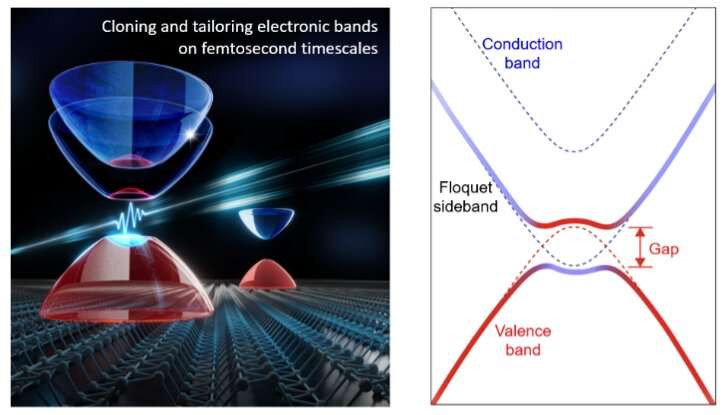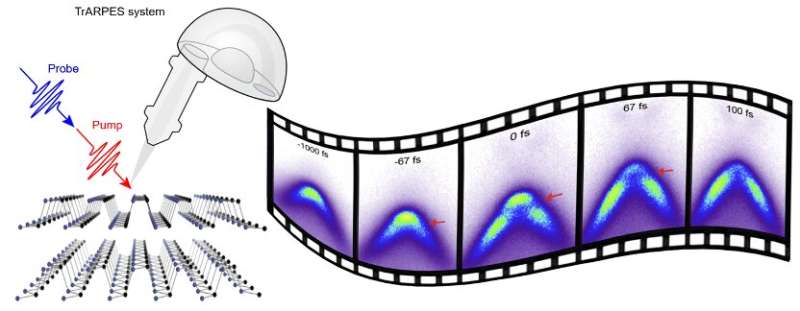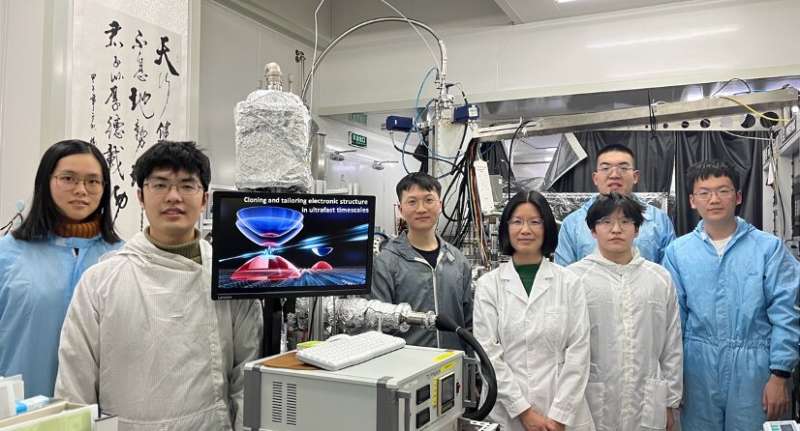
Physicists have been trying to identify reliable strategies to manipulate quantum states in solid-state materials, cold atoms and other systems, as this could inform the development of new technologies. One of these strategies is Floquet engineering, which entails the periodic driving of quantum states of matter.
Researchers at Tsinghua University, Beihang University and the Chinese Academy of Sciences in China have recently demonstrated the experimental realization of Floquet band engineering in a model semiconductor, namely black phosphorus. Their paper, published in Nature, could inform future research efforts exploring the Floquet engineering of semiconducting materials and trying to realize light-induced emerging phenomena, such as light-induced topological phase transitions.
“Light-matter interaction plays critical roles in experimental condensed matter physics and materials sciences, not only as experimental probes for revealing the underlying physics of low-dimensional quantum materials, but more importantly, as effective control knobs for manipulating the electronic structures and quantum states in the non-equilibrium state,” Shuyun Zhou, who initiated and directed this research, told Phys.org.
“Such nonequilibrium control provides the fascinating opportunities to induce new physical phenomena beyond those in the equilibrium state. Along this line, tailoring the quantum states of matter through time-periodic fields (i.e., Floquet engineering) has attracted extensive interests over the past few decades.”
Past studies have applied Floquet engineering to condensed matter systems, cold atoms and optical lattices. Theoretical works have also predicted intriguing phenomena based on Floquet engineering, such as light-induced topological phase transitions. Experimental evidence of Floquet engineering, however, is still relatively scarce.
“Many fundamental questions remain to be answered through experimental results,” Zhou said. “For example, can Floquet engineering be realized in a semiconductor under realistic experimental conditions? Addressing this question is important as semiconductors are widely used for electronic and optoelectronic devices.”

For several years, Zhou and his colleagues have been trying to identify favorable methods and experimental conditions for investigating light-induced emerging phenomena and realizing Floquet engineering in semiconductors. This can be particularly challenging, as Floquet engineering requires low photon energy and a strong peak electric field.
To meet these requirements, the researchers developed instruments that apply high-intensity mid-infrared pumping pulses. In their experiments, they combined these tools with a state-of-the-art measure known as time- and angle-resolved photoemission spectroscopy (TrARPES).
“We chose an almost-ideal semiconductor sample to start with—high-quality black phosphorus with a small band gap and high mobility, which could be favorable for realizing Floquet engineering,” Zhou said. “The most challenging aspect of our study is that this is still a widely unexplored area, and it is not clear what experimental conditions (pump photon energy, pump polarizations etc.) are favorable for inducing light-induced manipulation of the electronic structure. It is just like searching in the dark, and it has taken us quite a few years before we observed something.”
Zhou and his colleagues were ultimately able to observe the light-driven transient Floquet band structure modulation in black phosphorus by systematically fine tuning the photon energy, polarization and time delay in their sample. This is the first experimental demonstration of Floquet band engineering in a semiconductor.
“Our work provides important insights into the Floquet engineering of semiconductors, highlighting the importance of resonance pumping,” Zhou said. “While optical transitions have been conventionally viewed as detrimental for Floquet states, our work shows that indeed for a semiconductor, resonance pumping could be favorable and even critical for Floquet band engineering. This surprising finding provides a pathway for searching for Floquet engineering in quantum materials.”

The recent work by this team of researchers is an important step towards achieving of light-induced topological phase transition, a key goal in the field of quantum physics. Their findings could thus soon pave the way for new studies aimed at transiently manipulating topological states in ultrafast timescales.
The experimental methods used by Zhou and his colleagues are very promising for achieving lattice symmetry-enforced Floquet band engineering with a stronger pump polarization selectivity. These methods can be used to reliably turn on and off the Floquet band in semiconductors, which could support the development of new high-speed devices.
Peizhe Tang, one of the theorists who worked out the theory behind the pseudospin selection rules of the Floquet engineering in this work, commented, “this work clearly shows that the Floquet engineering physics can be further enriched by pseudospin, a quantum degree of freedom in analogy to spin.”
“This work paves an important step toward topological phase transition via Floquet engineering,” Zhou added. “The next step would be achieving light-induced topological phase transition or even inducing nontrivial topology in a topological trivial material on ultrafast timescales by Floquet engineering. In addition, we would like to extend Floquet engineering to many more solid-state materials.”
More information: Shaohua Zhou et al, Pseudospin-selective Floquet band engineering in black phosphorus, Nature (2023). DOI: 10.1038/s41586-022-05610-3
Journal information: Nature
© 2023 Science X Network

